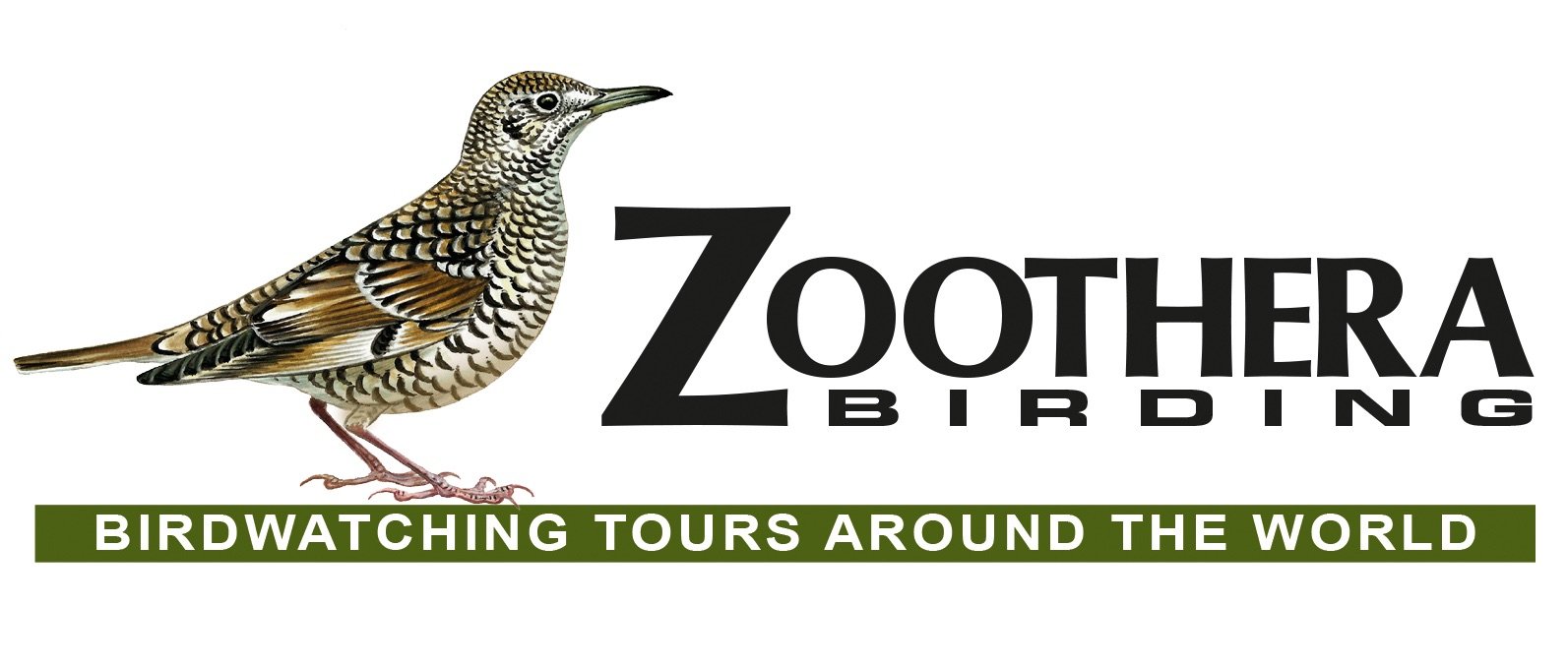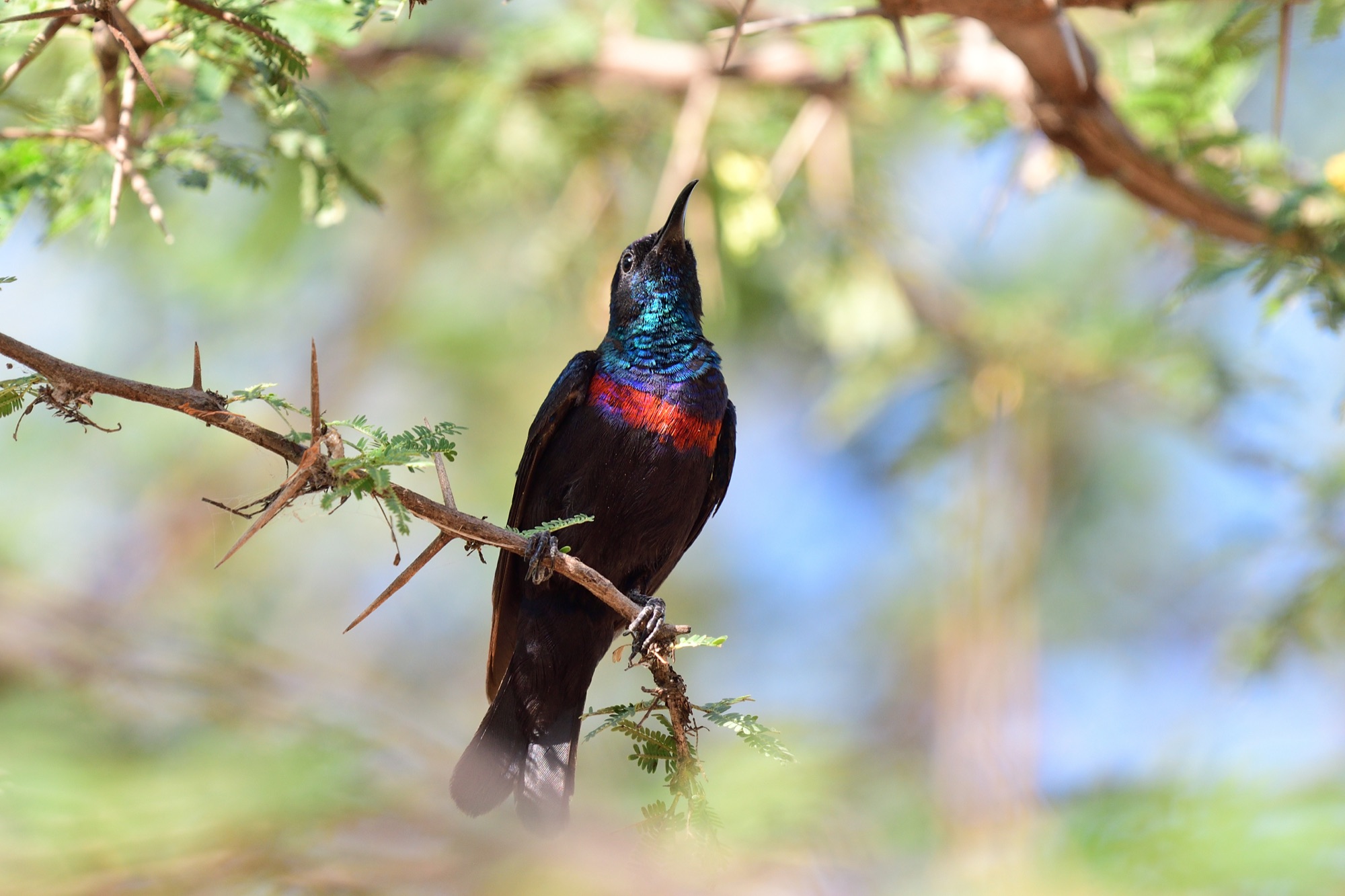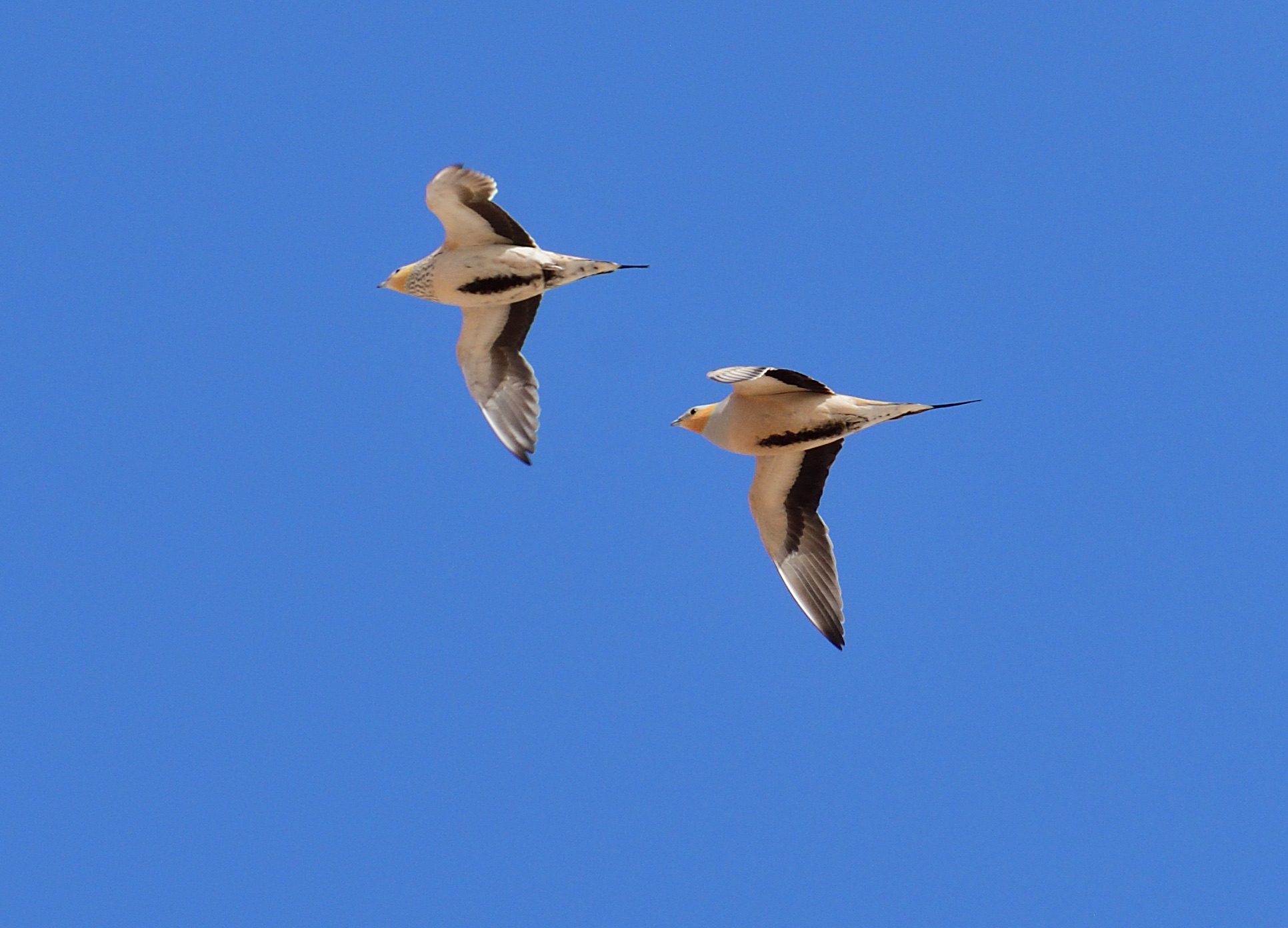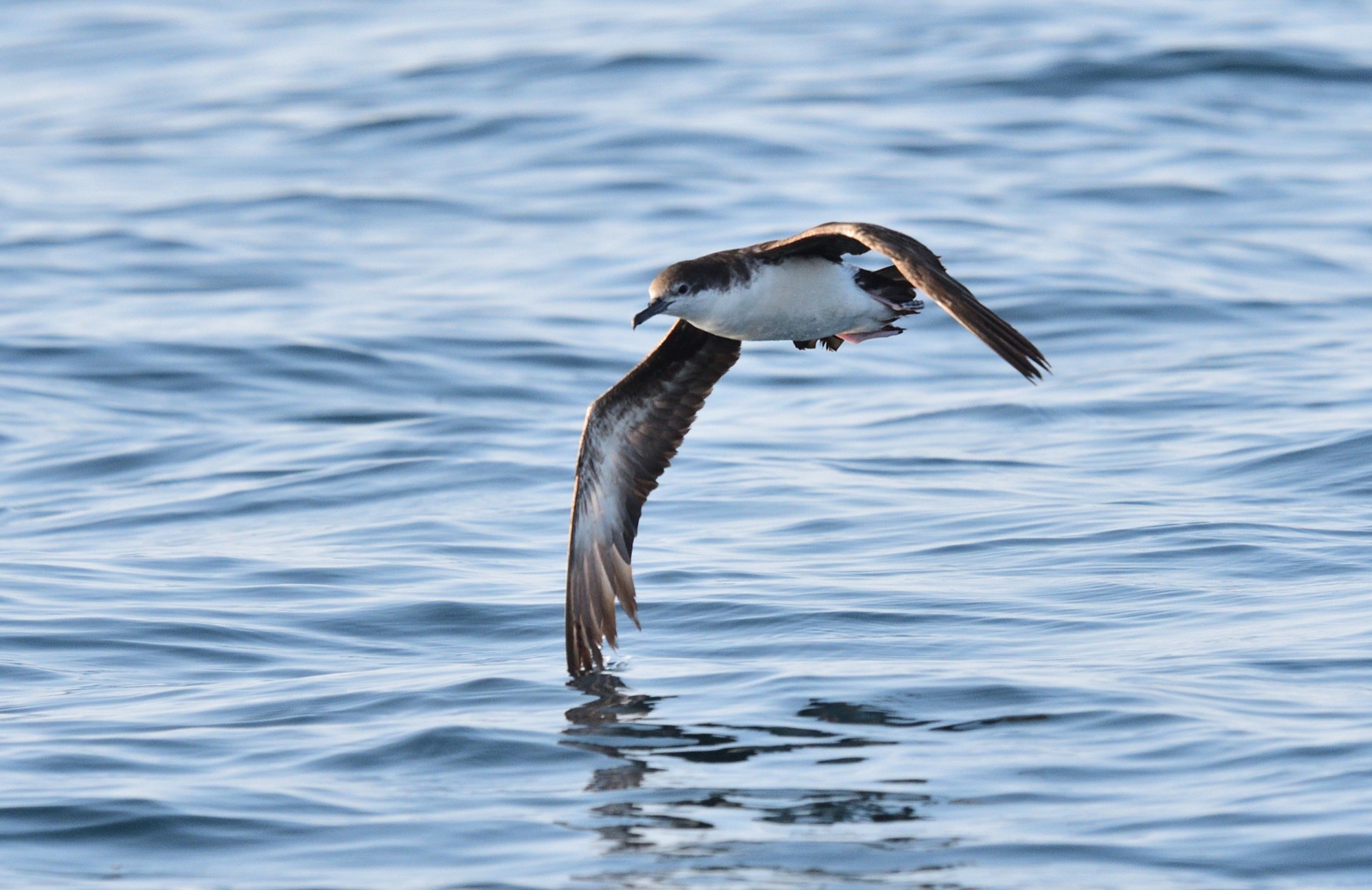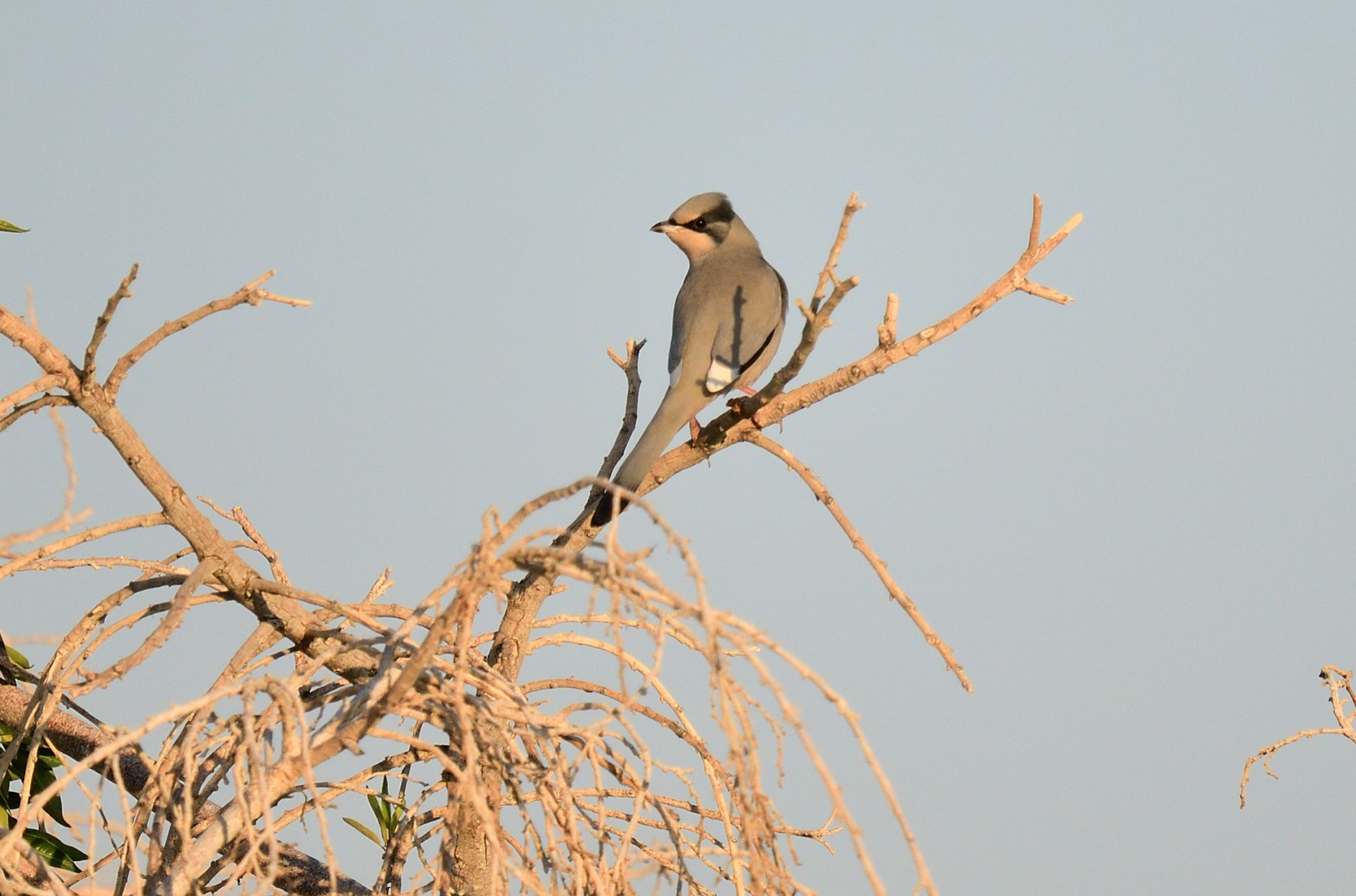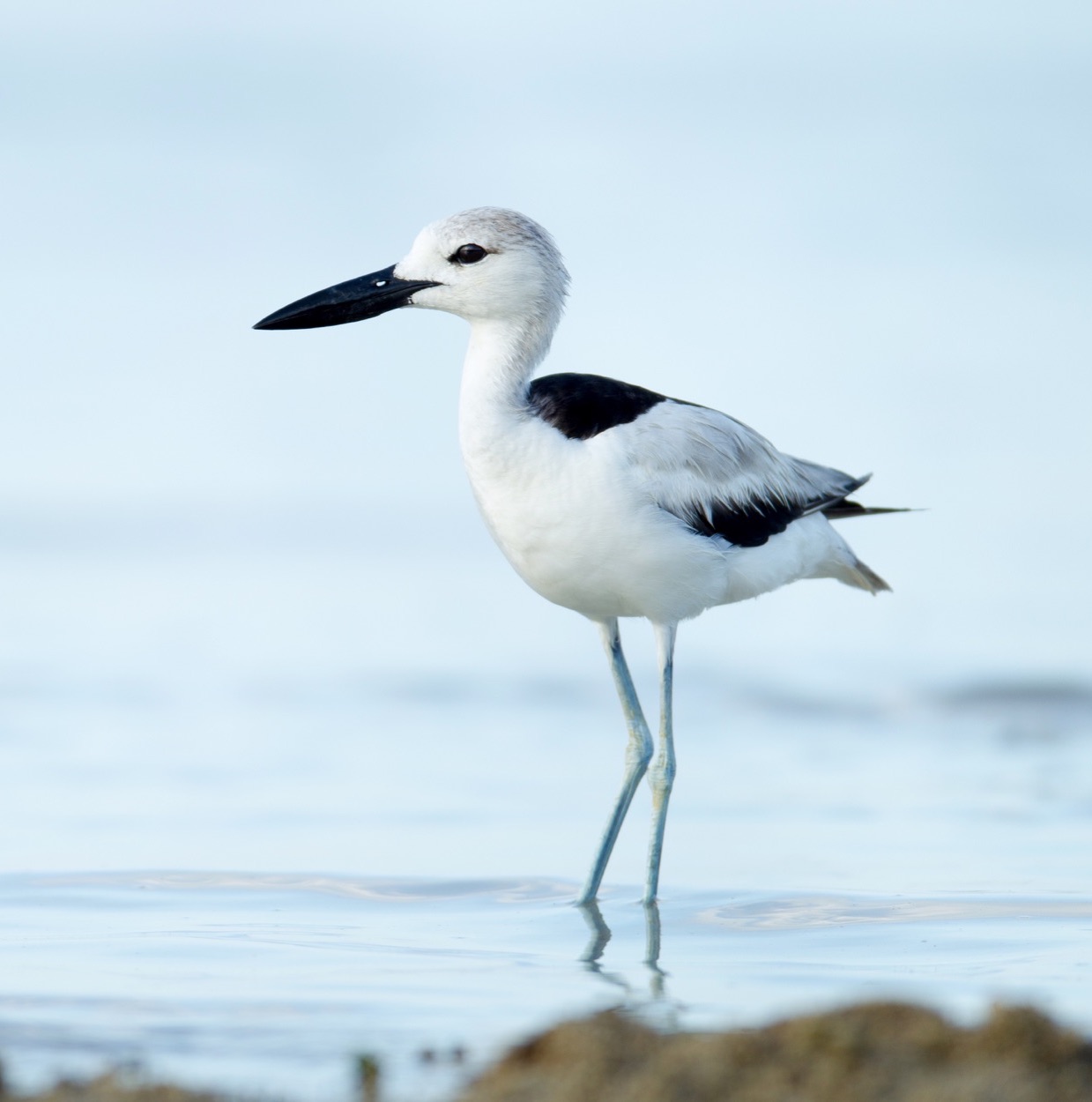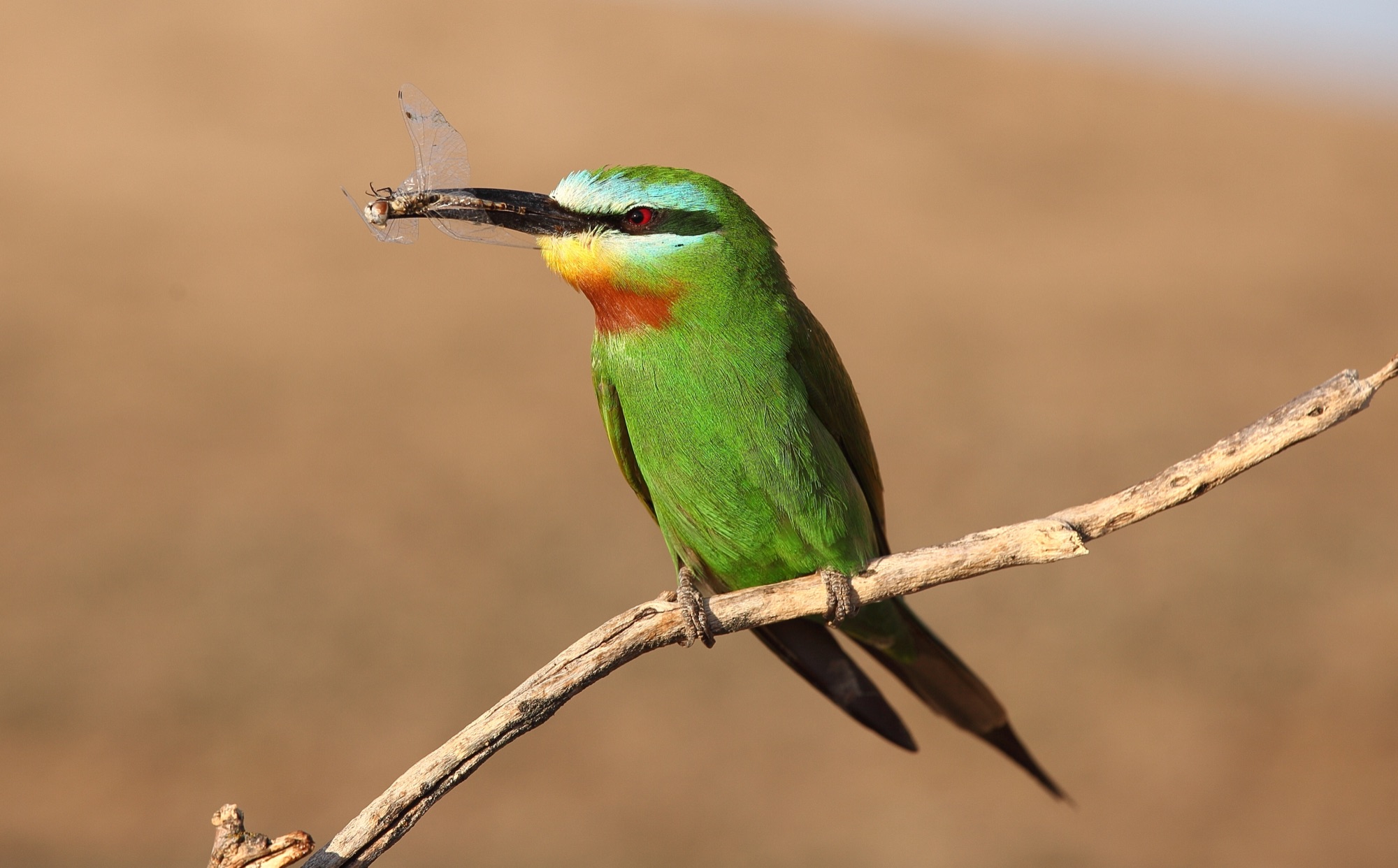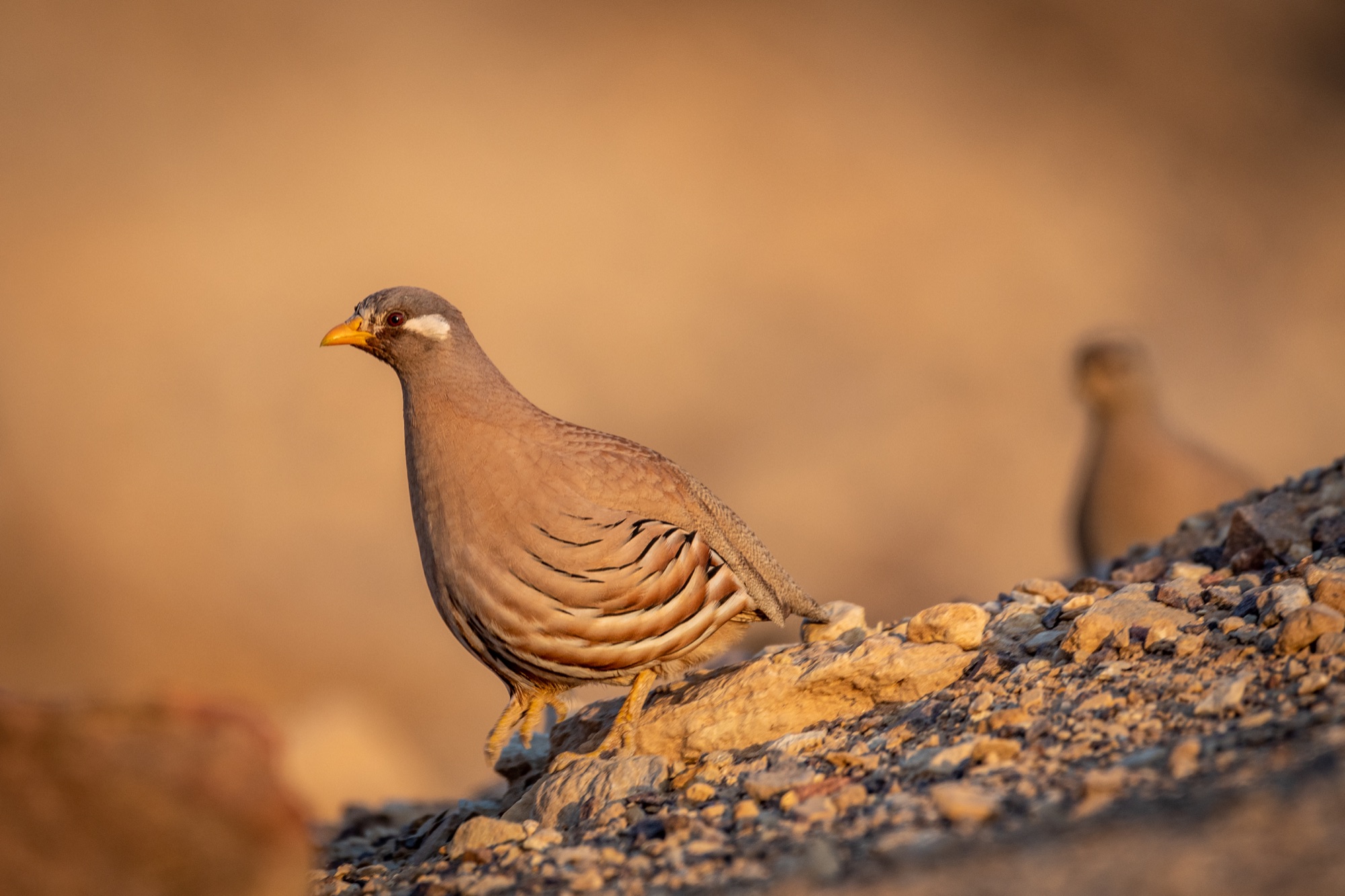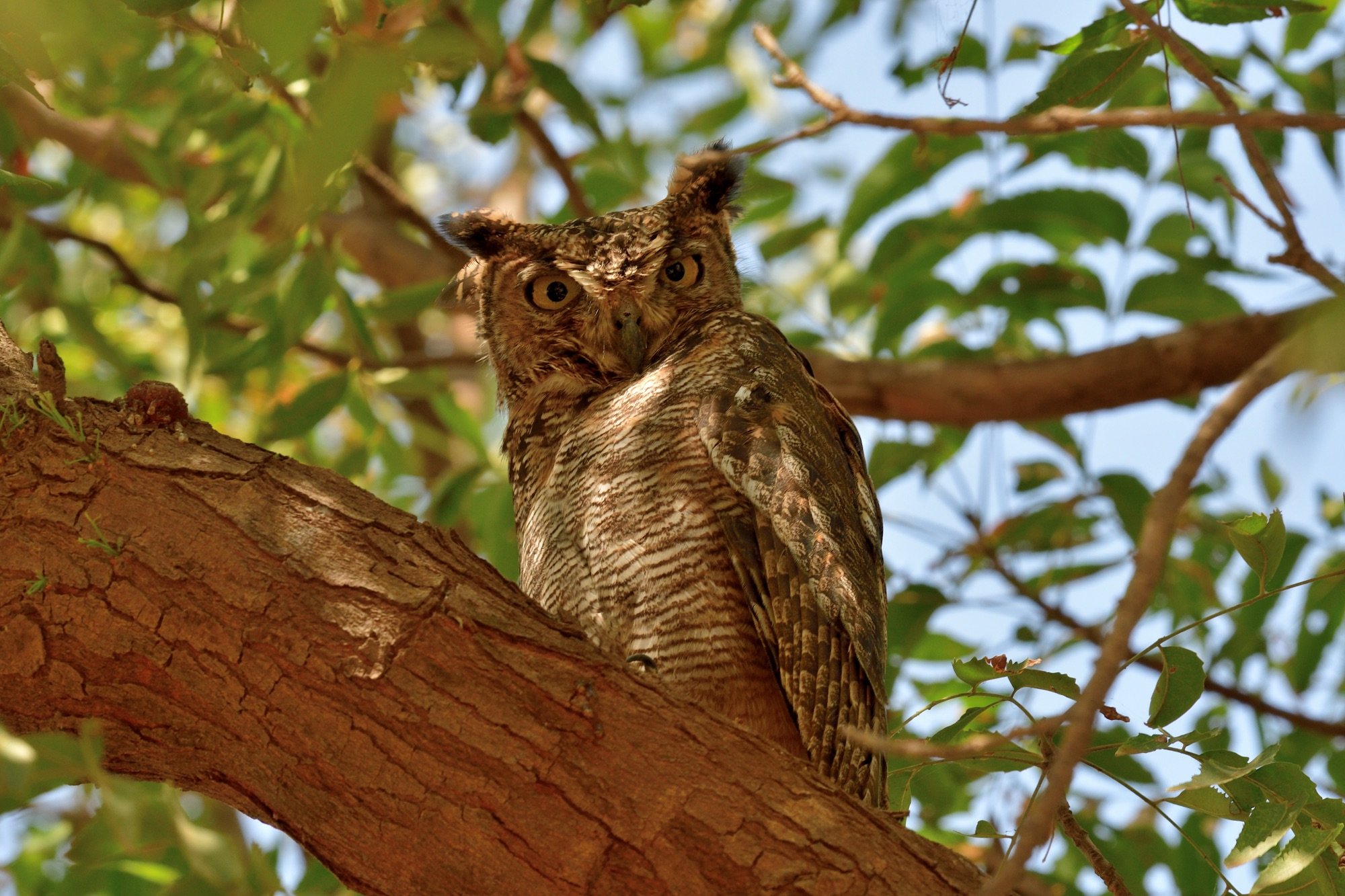CLASSIC OMAN BIRDING TOUR
DAY 0 ARRIVAL DAY
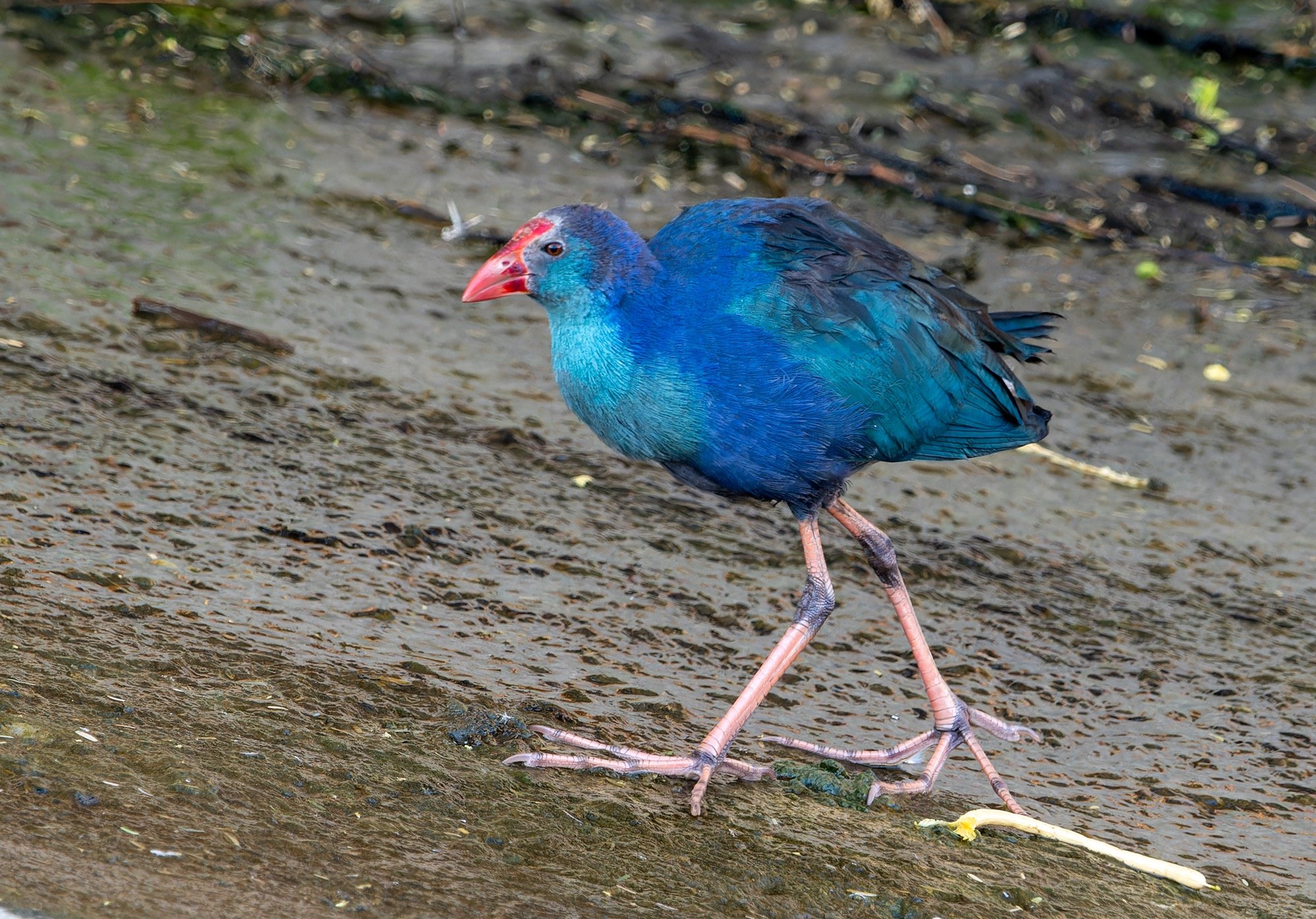
We thoroughly recommend arriving a day early and staying at an airport hotel today, just to rest and have a good night's sleep before the tour starts at 6.30am tomorrow. Night in Muscat.
DAY 1 AL FAHAL ISLAND - AL QURM BEACH - AL HAJAR MOUNTAINS
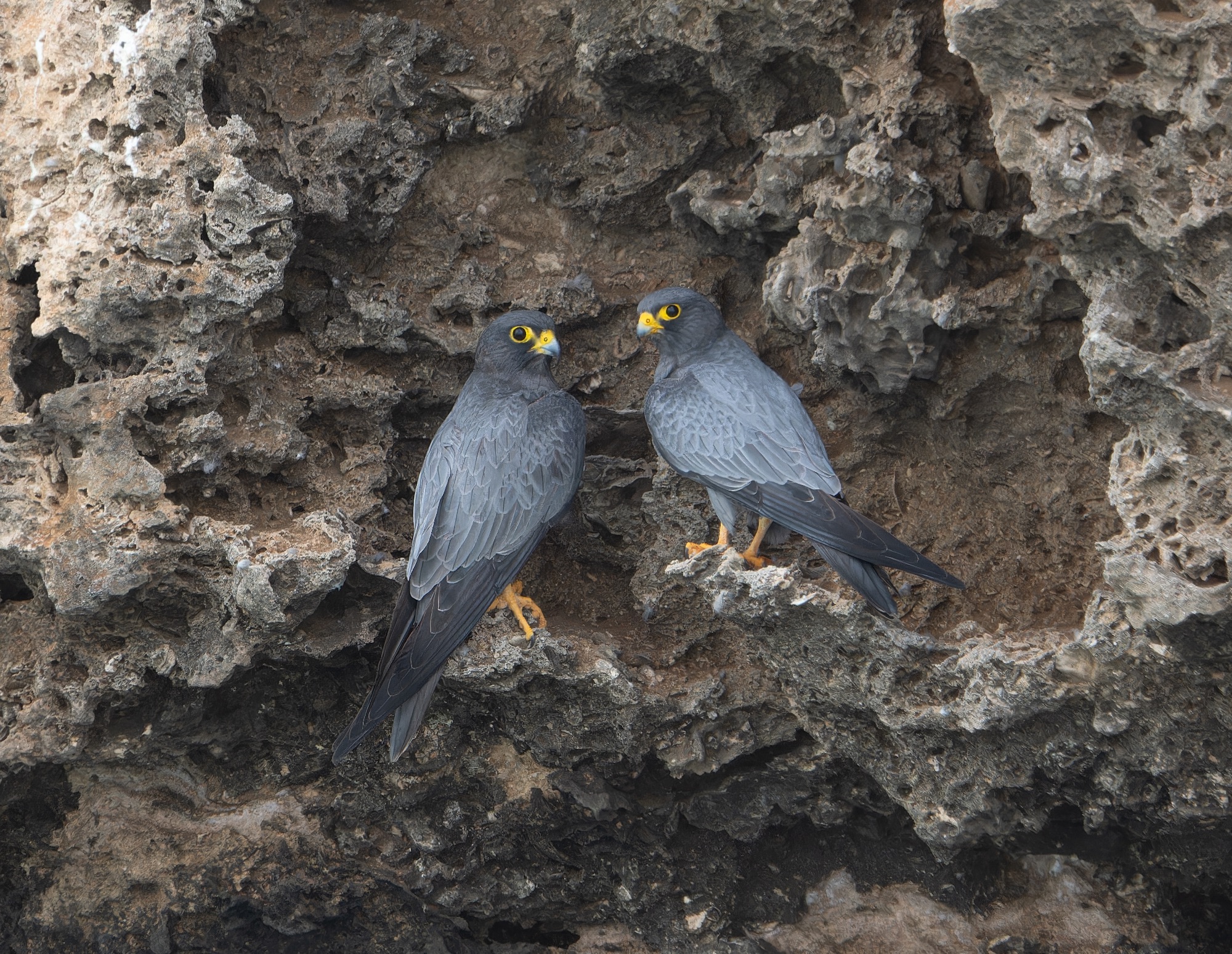
Our first port of call will be the reclaimed sewage pools of Al Ansab Wetlands where we will be booked in for 7am, just a 10 minute drive from the airport, and we have our first opportunity to set up scopes and view some common wildfowl and in the last few years it's been a good spot for Ferruginous Duck and Western (Grey-headed) Swamphen. There are other species such as Greater Flamingo, as well as our first shorebirds that could include Temminck's Stint, and it's one of those places that could provide the odd surprise as it is still migration time. In the surrounding area there's a few species that are only found in the north of the country, such as Grey Francolin, Red-wattled Lapwing, Red-vented Bulbul, Purple Sunbird, Indian Silverbill and more importantly, Delicate Prinia. We will bird our way along the Batinah coast as it holds a variety of shorebirds such as Greater and Lesser Sandplovers, Terek Sandpiper, and we can usually find a flock of Pacific Golden Plovers somewhere. And there's also Black-winged Kite, Short-toed Eagle, Chestnut-bellied Sandgrouse, Indian Roller, Pale Crag Martin, Steppe Grey Shrike, White-eared Bulbul and Bank Myna (rare) to name a few. We will also take a boat trip over to Al Fahal Island where we hope to see a few lingering Sooty Falcons, and there's also a chance of Red-billed (Arabian) Tropicbird that sometimes breeds here as well. There's also a visit to the Muscat Rivermouth and Al Qurum Beach to see what shorebirds, gulls & terns are present before we leave the coast in the afternoon and head up into the Al Hajar Mountains, just a couple of hours away where we will spend the next 3 nights.
DAYS 2 - 3 AL HAJAR MOUNTAINS
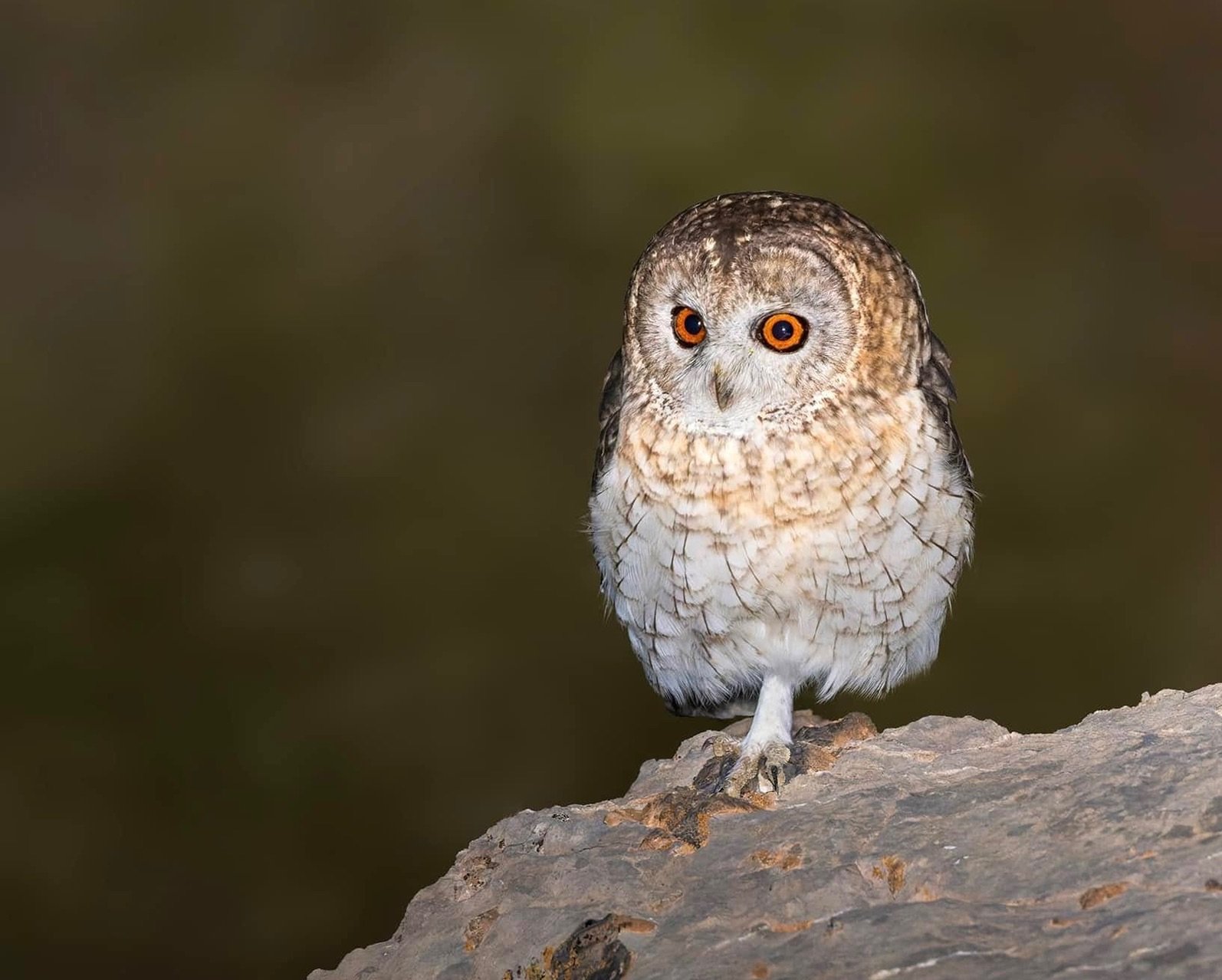
As we have 3 nights in the mountains, where we will stay at a couple different locations in order to get the best out of our time here. One of the most amazing ornithological discoveries happened in the Al Hajar Mountains as recently as 2013 when The Sound Approach Team discovered a new species of strix owl. (We thoroughly recommend reading their article about this amazing discovery). We will visit several different wadis at night, not too far from our accomodation where this mysterious bird inhabits extremely tall cliffs in remote areas. Omani Owl (Strix butleri) has been seen infrequently over the past few years by a handful of lucky observers, some of whom scaled the cliff sides to obtain a sighting. Needless to say, we won't be scaling any cliffs, but we have seen this owl on several occasions and we have now discovered a new site for Omani Owl and one that is not visited by other tour companies/birders, so our chances of seeing this rare species have risen dramatically. Our chances of finding Pallid Scops Owl are also very good and we haven't missed it yet, and we have also discovered a roost site for Pharaoh Eagle-Owl as well during our March 2025 tour.
During the daytime, these same scenically magnificent wadis are home to several other specialities of northern Oman such as Red-tailed (Persian) Wheatear, Hume's Wheatear, Streaked Scrub Warbler, Plain Leaf Warbler and Arabian Babbler. There's also one area in particular where we have a great chance of finding Lappet-faced Vulture as well. Other species we hope to find include Eurasian Woodpigeon, (which is an isolated population and a potential split), along with Long-billed Pipit, Pied Wheatear, Menetries's Warbler and Striolated Bunting. And somewhere over these few days we will come across a few migrants and wintering species that could include Rufous-tailed Rock-Thrush, Common & Black Redstarts (both with a distinctly 'eastern' flavour), Lesser Whitethroat (Halimodendri), and the mountain form of Desert Lark is regular at high elevations. Nights in the mountains!
DAYS 4 - 6 MASIRAH ISLAND - MAHOUT

We will leave the mountains after breakfast and drive south across the desert to Shannah Port. There's not too much in the way of bird life along this route, apart from one or two Egyptian Vultures, Greater Hoopoe-Lark, Desert & Isabelline Wheatears, Great Grey Shrike (Aucheri race), Asian Desert Warbler, numerous Brown-necked Ravens, and Black-crowned Sparrow-Lark. We are going to spend 2 nights on the migrant mecca of Masirah Island - dubbed 'The Fair Isle of Arabia', and one night in Mahout.
The ferry crossing from Shannah to Hilf takes around an hour and does give us an opportunity for a seawatch from the top deck. You never know quite what will pass by, but amongst a good variety of gulls & terns, it's quite possible to spot a Wilson's Storm-Petrel or even a Flesh-footed Shearwater! Once we are on the island there's not much driving, so most of our time will be spent on foot exploring Al Shamkaiah Park, the main migrant hotspot on the Island. There's a mouthwatering list of past rarities here and we even found the 5th Common Hawk-Cuckoo for Oman here in January 2025. Species such as Asian Koel, Red-breasted Flycatcher, Yellow-browed Warbler, Forest Wagtail and Olive-backed Pipit are almost to be expected these days! Rarer possibilities include Amur Falcon, Grey-bellied Cuckoo, Eastern Nightingale, Green, Eastern Orphan, Blyth's Reed & Booted Warblers, Blyth's Reed Warbler, Common Rosefinch, Brahminy Starling and even Rustic Bunting. Anything can and frequently does turn up here, so the possibilities are limitless! But that's not all, as next door to the park we can visit Hilf Sewage Treatment Works and Hilf Coastal Wetland, where the combination of pools and a stream, bordered by dense Acacia's, scrub and grass are a real migrant draw. We will work all of these areas repeatedly for any migrants that could include Pheasant-tailed Jacana, White-breasted Waterhen, Little & Spotted Crakes, Collared Pratincole, Jack & Pintail Snipes, White-tailed Lapwing, Bluethroat and many other possibilities. If there's going to be an Oriental Pratincole in Oman this year, then this is the place!
Half an hour further south is the sand & mudflats of Sur Masirah where we have outstanding opportunities to get really good views of Crab-Plover, with up to 500 forming a superb spectacle at high tide. Amongst the multitude of shorebirds we will also look for Great Knot, a species present in small numbers but usually stays reliable to one or two high tide roosting sites. Other species include Greater & Tibetan Sandplovers, Broad-billed & Terek Sandpipers. Just scanning through the multitude of shorebirds present is a highlight in itself and it's a fantastic place to see all of those familiar shorebirds from Europe - but in huge numbers. There's also many herons & egrets, up to 8 species of tern and a variety of gulls all present here. Again, we need to check every bird as it is highly likely thee's something rare hiding amongst the many thousands of birds flocking along the tideline.
Once we have returned to the mainland, our next hotel is near the shorebird mecca of Barr Al Hickman and we will check out the nearby sewage works in the late afternoon that can hold some interesting species. Previous tours have produced Black-necked Grebe, Garganey, Collared Pratincole, various shorebirds, Bluethroat, Red-throated Pipit, and a variety of Western Yellow Wagtail races.
DAY 7 MAHOUT - FILIM - AL GHAFTAIN
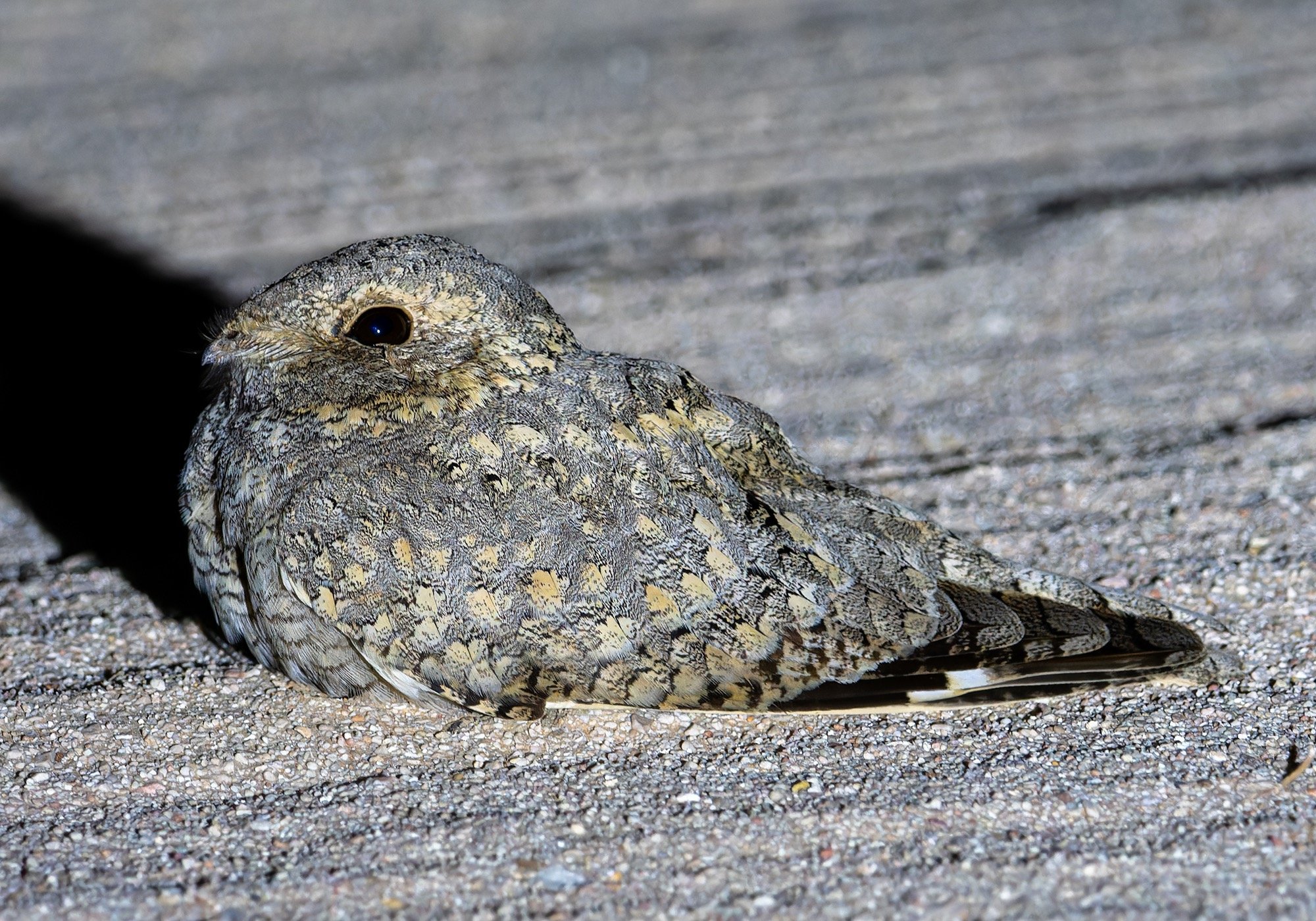
Although we will have seen most of the potential shorebirds here, we will spend the early morning in this fantastic area at Filim. Amongst the multitude of shorebirds we need to scan carefully for anything rare, as in 2022 we found the 1st Grey-tailed Tattler for Oman here and in March 2025 the 1st Hudsonian Whimbrel. Just scanning through the 'hundreds of thousands' of shorebirds present is a highlight in itself and it's a fantastic place to see all of those familiar shorebirds from Europe - but in huge numbers. We will also check the nearby mangroves for Collared Kingfisher, here at one of the few places in Oman it is possible to see this species, along with a slim chance of seeing Oriental White-eye - a small population is resident in the mangroves but is seldom seen.
Following this we will drive west across the Empty Quarter for around 3 hours to the town of Haima. Along the way there are a few small parks that can be really good for migrants, as is the park in Haima where we have seen Forest Wagtail, Upcher's Warbler and others. Then we will head down to the Al Ghaftain Motel, where we will spend the night and check out the gardens, which at this time of year often hold some interesting migrants. Any self-respecting migrant is going to linger here amidst the green trees! Anything is possible and as well as this being one of the spots Grey Hypocolius has previously turned up, other possibilities include Eurasian Scops Owl, Asian Koel, Eurasian Wryneck, Masked & Woodchat Shrikes & Menetries's Warbler, We have also observed Steppe Buzzard, Jacobin Cuckoo, Red-breasted Flycatcher, Siberian Chiffchaff, Hume's Warbler, the 4th Hume's Whitethroat for Oman and others. If time permits a late afternoon visit to Maqshin Oasis could provide yet more migrants before we reach Muntesar Oasis at sunset. This is our best chance of seeing Egyptian Nightjar, and in the past couple of years there has been the exceptionally rare Sykes's Nightjar spending the winter as well. Night at Al Ghaftain.
DAY 8 MUNTESAR OASIS - QATBIT - SHISR FIELDS - THUMRAIT
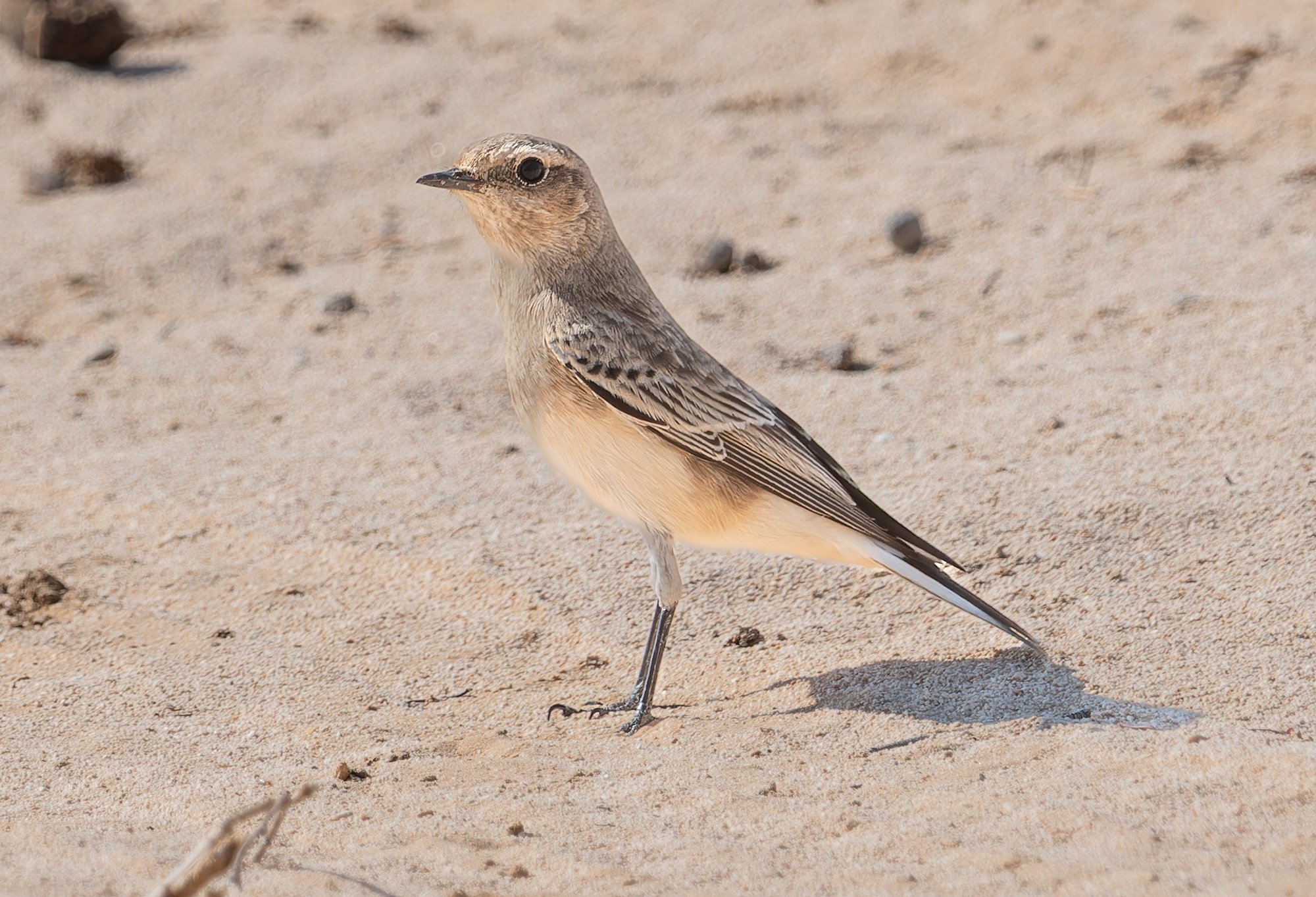
We will spend the early morning around the Muntasar oasis, an excellent site that attracts a flock of Spotted Sandgrouse, along with groups of Chestnut-bellied Sandgrouse. As this is an oasis with a permanent water source, you just never know what you will find. If we get here before sunrise there's a further chance of Egyptian Nightjar, whilst there's two races of Great Grey Shrike possible, as well as flocks of Blue-cheeked Bee-eaters, Menetries's & Asian Desert Warbler, Water Pipit, Yellow Wagtails of several different races, occasionally African Collared Dove, and both Turkestan and Daurian Shrikes. On previous visits we have found European Nightjar, Great Snipe, Red-breasted Flycatcher, Tawny & Richard's Pipits, Pied Wheatear, Siberian Chiffchaff, Paddyfield Warbler, Song Thrush and many other commoner migrants. Seeing Dunlin and Temminck's Stints out here in the middle of the desert is also a very humbling experience! Anything could appear here and we are sure of a surprise or three!
Heading to Thumrayt mid-morning we will check a couple of farms along the way and these irrigated fields act like a magnet, offering us further chances of some really good species. There's always a slim chance of Arabian Lark but we won't be holding our breath!. Amongst a wide variety of species present along our route, we could see flocks of White Storks, more Chestnut-bellied and Spotted Sandgrouse, Eastern Imperial, Steppe & Greater Spotted Eagles, Pallid & Montagu's Harriers, Long-legged Buzzard, European Roller, flocks of larks usually comprise Greater Short-toed, some Black-crowned Sparrow-Larks and the odd Bimaculated Lark if we are lucky, as well as Desert & Isabelline Wheatears, both of which are numerous. There's a relatively new site called Shisr Fields that in the past few years has become THE place to visit, way out here in the desert and where on our previous tours we have seen a small group of Sociable Lapwings & flocks of Rosy Starlings. It's also one of the best sites for Cream-coloured Courser, and we've also seen Eurasian Cuckoo & Siberian Stonechat here, whilst major rarities such as Red Collared Dove, Wattled & Brahminy Starling have been observed by others. This will undoubtedly mean a late arrival at our hotel in Thumrait tonight!
DAY 9 MUDDAYY - SALALAH

Early this morning we will make the pilgrimage to the desert village of Muddayy where the much-wanted Hypocolius winters in small numbers. They are becoming quite elusive but we've seen them on every tour so far, so fingers crossed! This is also a good area for Sand Partridge, African Collared Dove, Hooded Wheatear (rare), Desert Lark, Blackstart and Nile Valley Sunbird. In between searching for Hypocolius we will have to drive a short distance to a small watercourse where at the appointed time many hundreds of Chestnut-bellied Sandgrouse fly in to drink. And if we are lucky, there should also be some Crowned Sandgrouse mixed in with them. When we discovered this spot, no-one else knew about it, but unfortunately the word has spread and quite often other birding groups try and stand too close to the pools and disturb the flocks of sandgrouse. So hopefully we are early enough in the season to avoid this!
We are usually finished birding here by lunchtime and will then drive just under 2 hours to Salalah, where we will stay for the next 5 nights. A whole different mix of birds will confront us in the late afternoon and we should see African Paradise-Flycatcher, Arabian and Palestine Sunbirds, Abyssinian White-eye, Rüppell’s Weaver, African Silverbill and Cinnamon-breasted Bunting amongst others. This evening we can stay out until sunset and wait for Arabian Scops Owls to become active. They usually perform very well and can be quite inquisitive. 1st of 6 nights in Salalah.
DAYS 10 - 14 SALALAH AREA

We are in for a very busy stay here in Salalah! Just what we do and where we go each day will vary on what species we are targetting. There are a number of Arabian specialities to find and there's plenty of great general birding to be had, with a species mix comprising birds from the Afrotropical, European and Oriental regions all meeting here. Arabian Golden-winged Grosbeak will possibly be our No.1 target and we will visit a series of wadis running into the Jabal Al Qara escarpment that have streams running through them, creating a green and lush habitat in this desert environment.
Most of the birding sites are within 20 - 45 minutes of our lovely seaside resort, so we can visit many different sites and habitats each day. Ayn Hamram is usally our first stop and is one of our favourite sites which has permanent water and a pool, as well as some much-needed shade created by several large trees once the day heats up.. We've found the 7th, 8th & 9th Blyth's Reed Warblers for Oman here, as well as seeing species such as White-breasted Waterhen, Bruce's Green-Pigeon, Grey-headed Kingfisher, European Roller, Diderik Cuckoo, flocks of Blue-cheeked Bee-eaters, Eurasian Hoopoe, Forbes-Watson's, Pallid & Alpine Swifts, Turkestan, Daurian, Woodchat and Masked Shrikes, Blackstart, Red-breasted Flycatcher, Eastern Nightingale, White-spectacled Bulbul, Graceful Prinia, Arabian Warbler, Eastern Olivaceous Warbler, Upcher's Warbler, and once we saw a Wolf! There's always groups of Abyssinian White-eyes here, along with Black-crowned Tchagra, Ruppell's Weavers, African Silverbills and Cinnamon-breasted Buntings, as well as Arabian & Palestinian Sunbirds, African Paradise-Flycatchers and more!
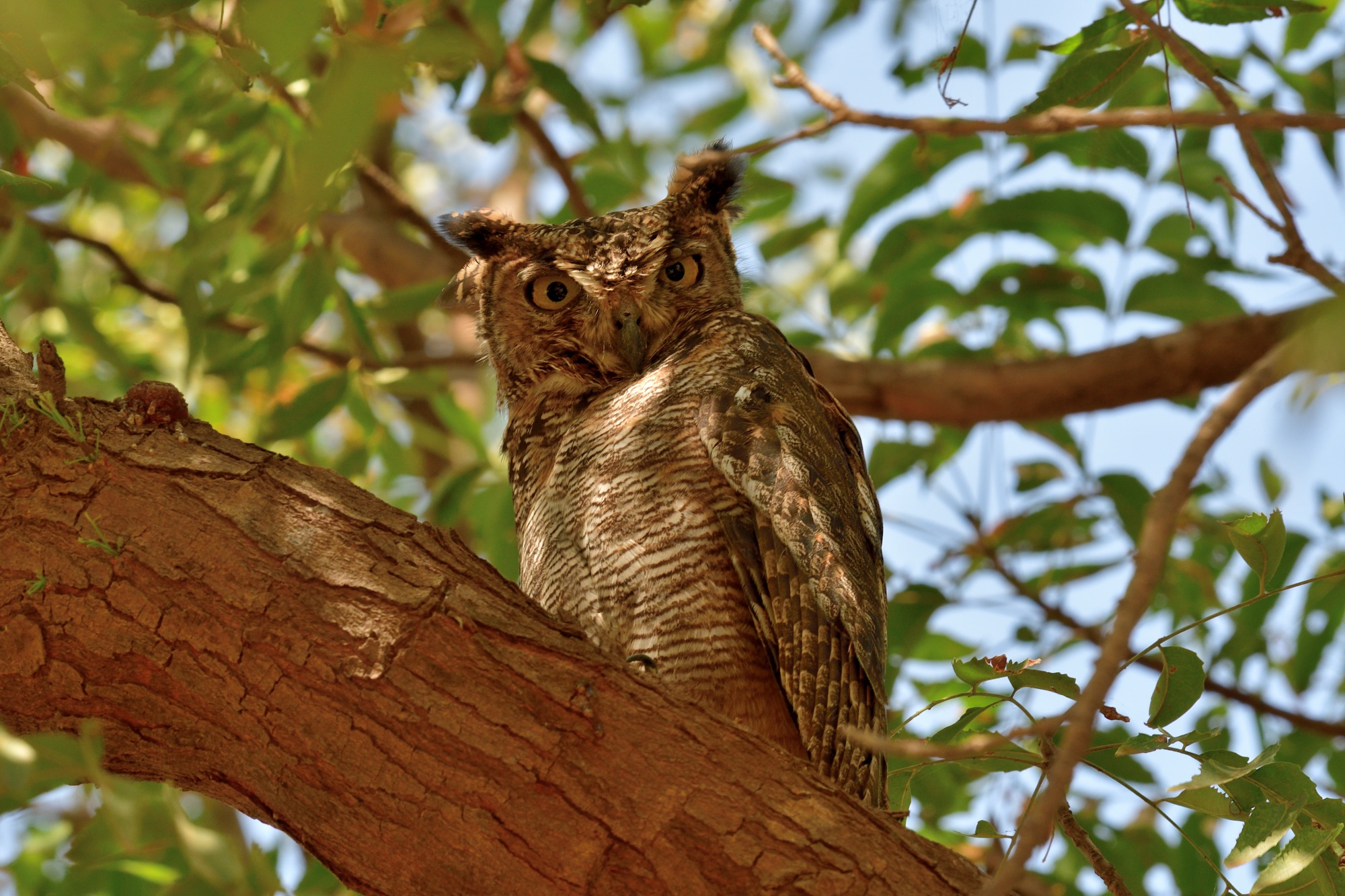
Nearby Wadi Kheesh can have many of the same species but is more arid and is another site for Arabian Grosbeak. A drinking trough often proves attractive to many birds mid-morning and provides fascinating entertainment as they are often oblivious to our presence and we get exceedingly close views. It's also another good site for Black-crowned Tchagra and Arabian Warbler, whilst Arabian Grosbeak is a sporadic visitor.
The famous Ayn Tobruq and it's drinking trough has proven to be a fairly reliable site for grosbeaks and is still a very important site to check in the early morning. The drinking trough and dripping tap provide a valuable source of drinking and bathing water for all the usual species as well as Namaqua & Laughing Doves, Black-crowned Tchagra, Tristram's Starlings and sometimes Eurasian Wryneck. The drive along the plains usually holds several large eagles and we have had Eastern Imperial, Steppe and Greater Spotted Eagles all feeding on the same carcass on several visits in this area. The plains are also good for Black-crowned Sparrow-Lark, and we can usually find Cream-coloured Courser somewhere out in this vast area. And once we had a Caspian Plover too.
Ayn Razat is another wadi with permanent water with all the same species although is very good for Arabian Partridge, Arabian Warbler, and is also one of the better spots for Arabian Eagle Owl. We've also had White-breasted Waterhen, Long-billed Pipit and once found an African Openbill, which was a 1st for Oman!
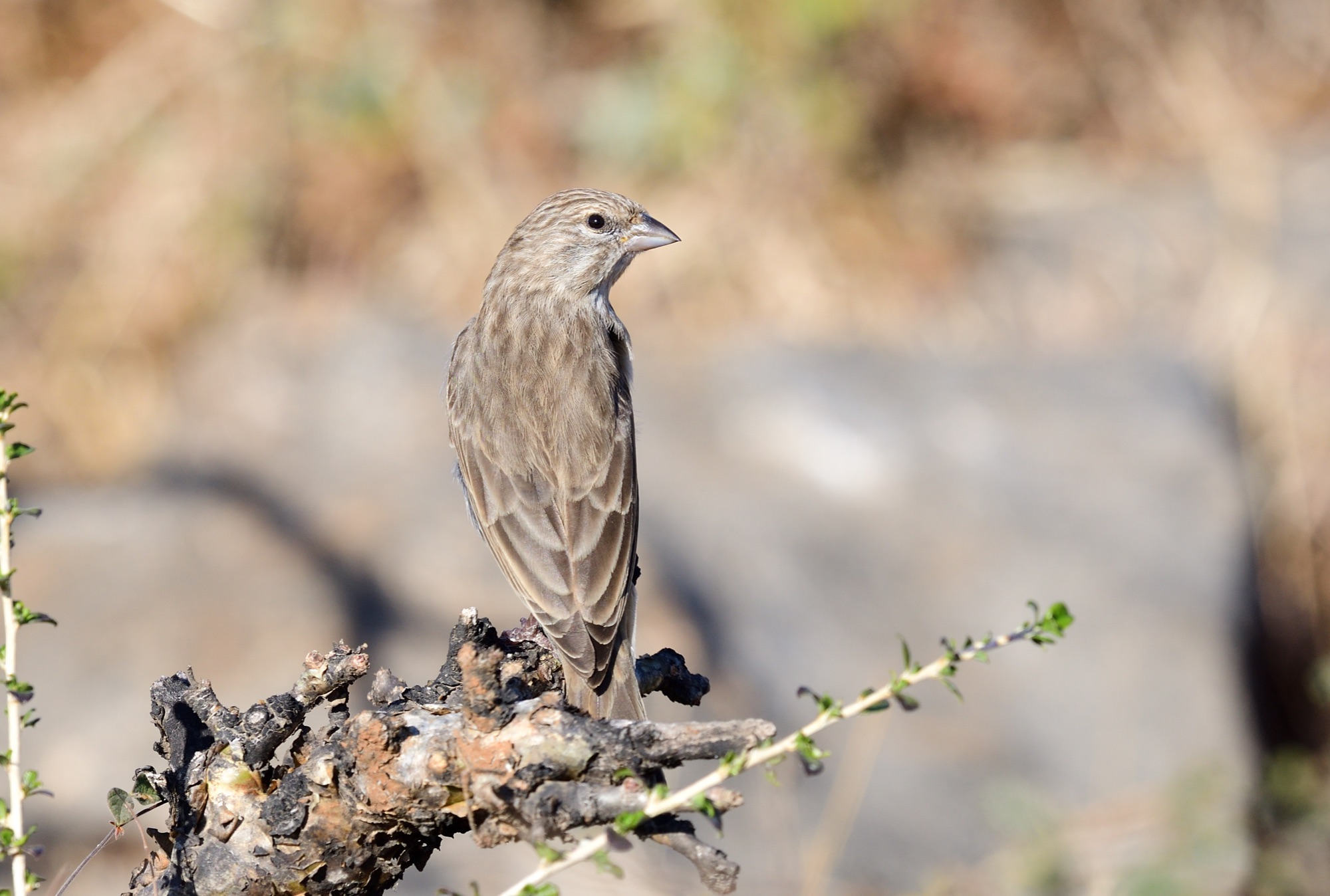
Meanwhile up on the plateau at the famous sinkhole of Tawi Atayr we can find a small flock of Yemen Serins roving around the lip of this large hole! There's usually a pair of Bonelli's Eagles giving superb views and we can look down on them as they soar across the chasm, whilst this one of many sites that you can see Arabian Partridge. Further across the plateau is Jabal Samhan, the stake-out for Verreaux's Eagle and there can be no better view to watch this spectacular raptor. It's also a decent spot for Arabian Wheatear and Fan-tailed Raven too, and one of the few places we've seen what used to be called Barbary Falcon, although that species has been lumped into Peregrine Falcon now. There's usually one or two Rock Hyrax's present as well.
The furthest wadi heading east is Wadi Darbat, easily the most wooded of all the valleys running into the escarpment. It's home to several pairs of Arabian Eagle Owl and numerous Arabian Scops Owls, but it can be quite difficult to work. Again, there's a permanent water source and species such as Cotton Pygmy Goose, Pheasant-tailed Jacana and Malachite Kingfisher have been seen here. It has a nice cafe at the far end and it's always worth scanning for Forbes-Watson's Swifts, as well as Pallid and Alpine Swifts, plus there's usually a variety of raptors including Booted and Short-toed Eagle present. During the middle of the day it's a good place to have a picnic and you can often find a variety of species taking advantage of the shade as well, including Masked Shrike, Wood Warbler, Lesser Whitethroat, African Paradise-Flycatcher, several other migrants & wintering species as well. Probably the biggest draw is for anyone looking for mammals at night as various species have been seen, including a Wolf by one of our groups
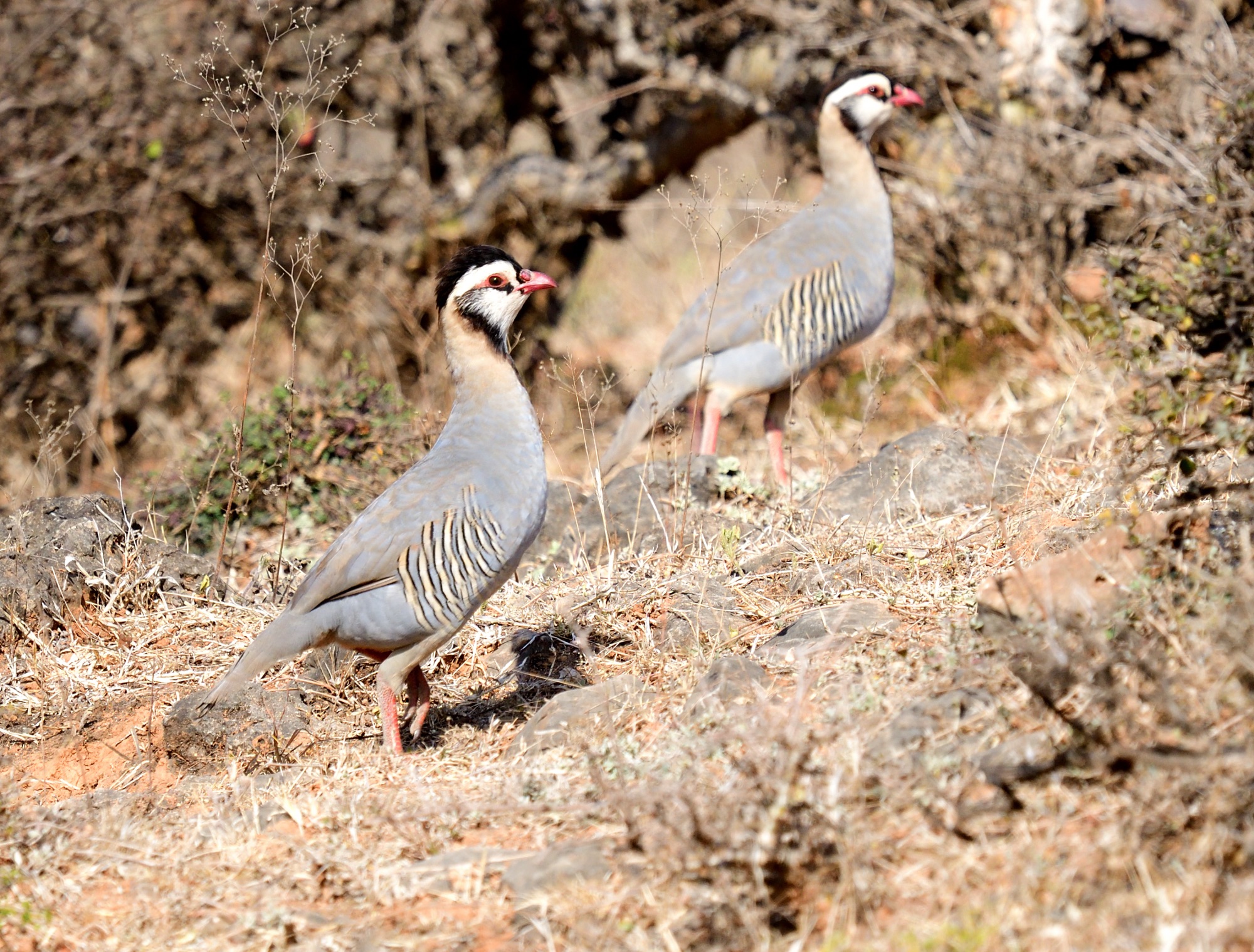
What adds to the excitement of birding the Salalah area is the numerous inland lagoons or khawrs as they are known. They prove attract to many resident and migrating species from points east and west and add such an unpredictability to our birding that you just never know what to expect. Below Wadi Darbat is Khawr Rawri, which used to be the premier birding site in the region. That was until a typhoon wrecked the habitat but it is slowly recovering and still draws in plenty of good birds. Even along this portion of coast we can still find Arabian Partridge, whilst the lower section of the lagoon holds roosting egrets and herons, and shorebirds can include Broad-billed Sandpiper, Kentish Plover and Pin-tailed Snipe. On one tour there was a Black Stork present here too. The higher reaches of the lagoon have better habitat and we've seen Pheasant-tailed Jacana, a variety of shrikes, and there's usually a flock of Citrine Wagtails present along with numerous races of Yellow Wagtail, and on one occasion there was a flock of Rosy Starlings. We will also explore multiple lesser known sites along the coast that have produced some really good species such as Buff-breasted & Pectoral Sandpipers, Knob-billed Duck, Lesser Whistling-Duck, Crab-Plover, Reed Cormorant, Lesser Flamingo, Wire-tailed Swallow, and in the distant past even African Skimmer! So each day is going to be full on and there's no chance of being complacent!
The crown jewel of the coastal lagoons is East Khawr, situated right on the very edge of Salalah. This is an awesome place and we will visit it multiple times. It produces new birds on every visit and every time we go there the species mix is completely different. Flocks of loafing gulls comprise of the ultra common Sooty, Heuglin's and Steppe Gulls, with many Slender-billed Gulls and the odd Black-headed and Caspian Gull. Most of them are almost in touching distance! There's always a Caspian Tern and Greater Crested Terns standing at the water's edge, which we usually drive right up to. Flocks of Common Terns often attract stunning White-winged Terns, although now we only have Little Terns as the current concensus is that Saunders's Terns don't occur at this time of year. The flock of Greater Flamingo's is usually joined by Eurasian Spoonbills, whilst a big flock of Glossy Ibis is always present, along with a huge flock of Ruff. This is one site you can have Indian Pond Heron standing alongside Squacco Herons, Wood, Green and Common Sandpipers next to each other, Marsh Sandpiper feeding alongside Common Greenshank (check out those bills), Little and Temminck's Stints feeding right next to our parked SUV's (look at those legs!). Get your camera's ready! And it's invaluable experience for birders of all abilities. We love this place! Add in species we've found such as Cotton Pygmy Goose cruising beside Garganey and Common Teals, groups of Red-knobbed Coots, occasional Yellow Bittern, the odd White-tailed Lapwing, and even Small Pratincole or the commoner Collared Pratincole and you can see why you can't be complacent here. as there are rarities to find! We even had a Masked Booby land on the beach once!
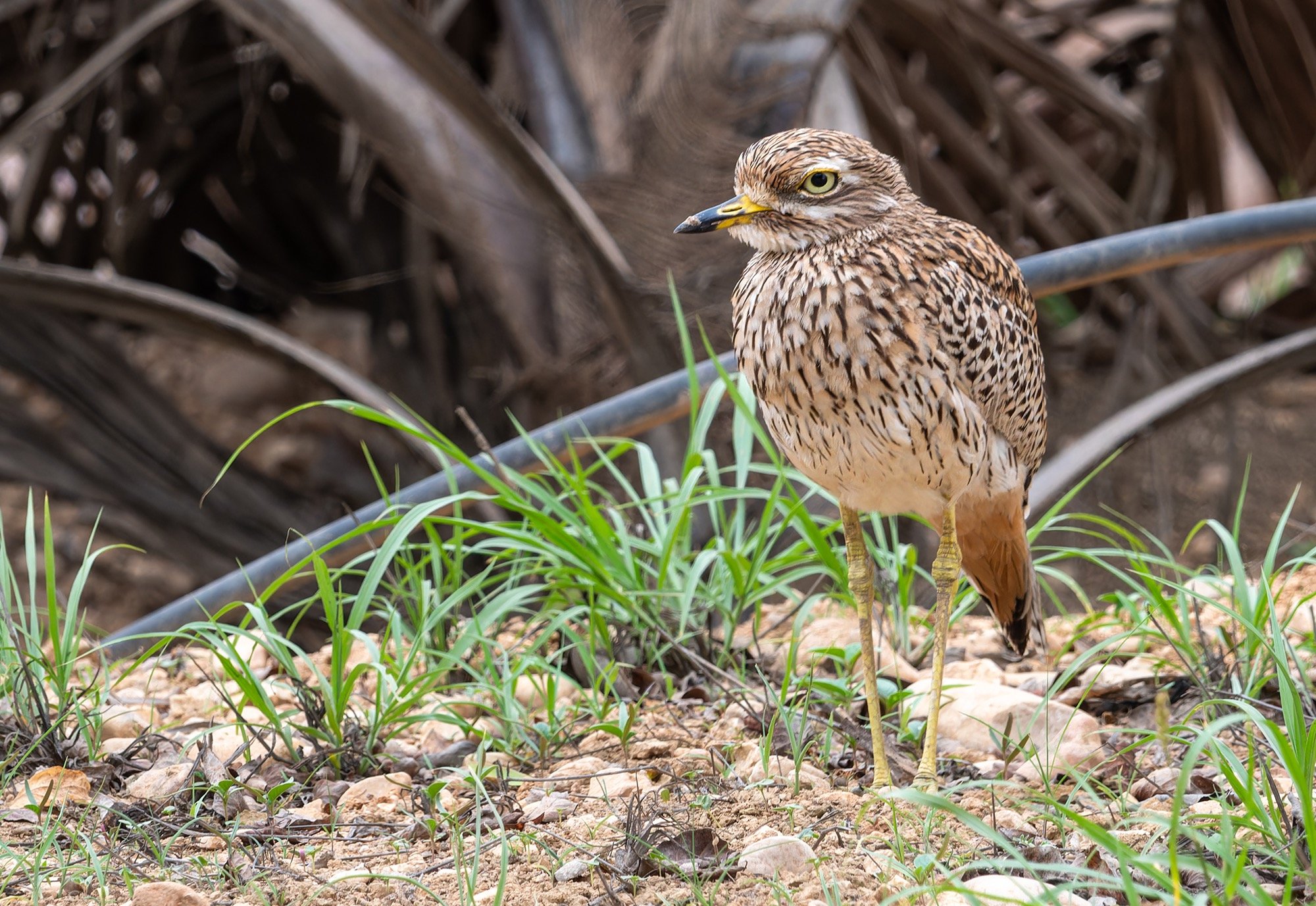
On the othe side of Salalah is Raysut Sewage Works which holds a big flock of White and Abdim's Storks and is the best place to see Spur-winged Lapwing in the area. And this is just inland from a personal favourite of ours, of Khawr Raysut that has an enviable track record of producing rarities such as Crab Plover, Pallas's Gull, and where the same African Openbill used to hang out. We even found Oman's 4th Dalmatian Pelican here! Many of the same species as East Khawr can be found here, but it is better for Lesser Crested Tern, Red-necked Phalarope, and both Broad-billed and Terek Sandpipers. The location is a little more remote than East Khawr and there's huge potential for finding something unusual. It is another fantastic location for observing gulls and terns including White-cheeked and plenty of shorebirds. Plus there's usually many Osprey's and Greater Spotted Eagles loafing on the mudflats when the tide is out. From the shore we have also seen Brown & Masked Booby & Socotra Cormorant feeding out in the bay.
Even in downtown Salalah there are several spots worth checking as it usually holds a few Crested Honey Buzzards in the parks, there's a location for Spotted Thick-knee, and Salalah Nature Reserve held Oman's 2nd Buff-breasted Sandpiper in 2022. Other sites can yield Singing Bushlark, Yellow Bittern, Grey-headed Kingfisher, Yellow-throated Sparrow and others. In January 2025 we saw a flock of Wattled Starlings along the main road! If there is access to Sahnawt Farm (although this is increasingly unlikely) it can produce some good birds and we have found White-tailed Lapwing, Masked Wagtail and Oman's 1st Banded Martin on our first tour.
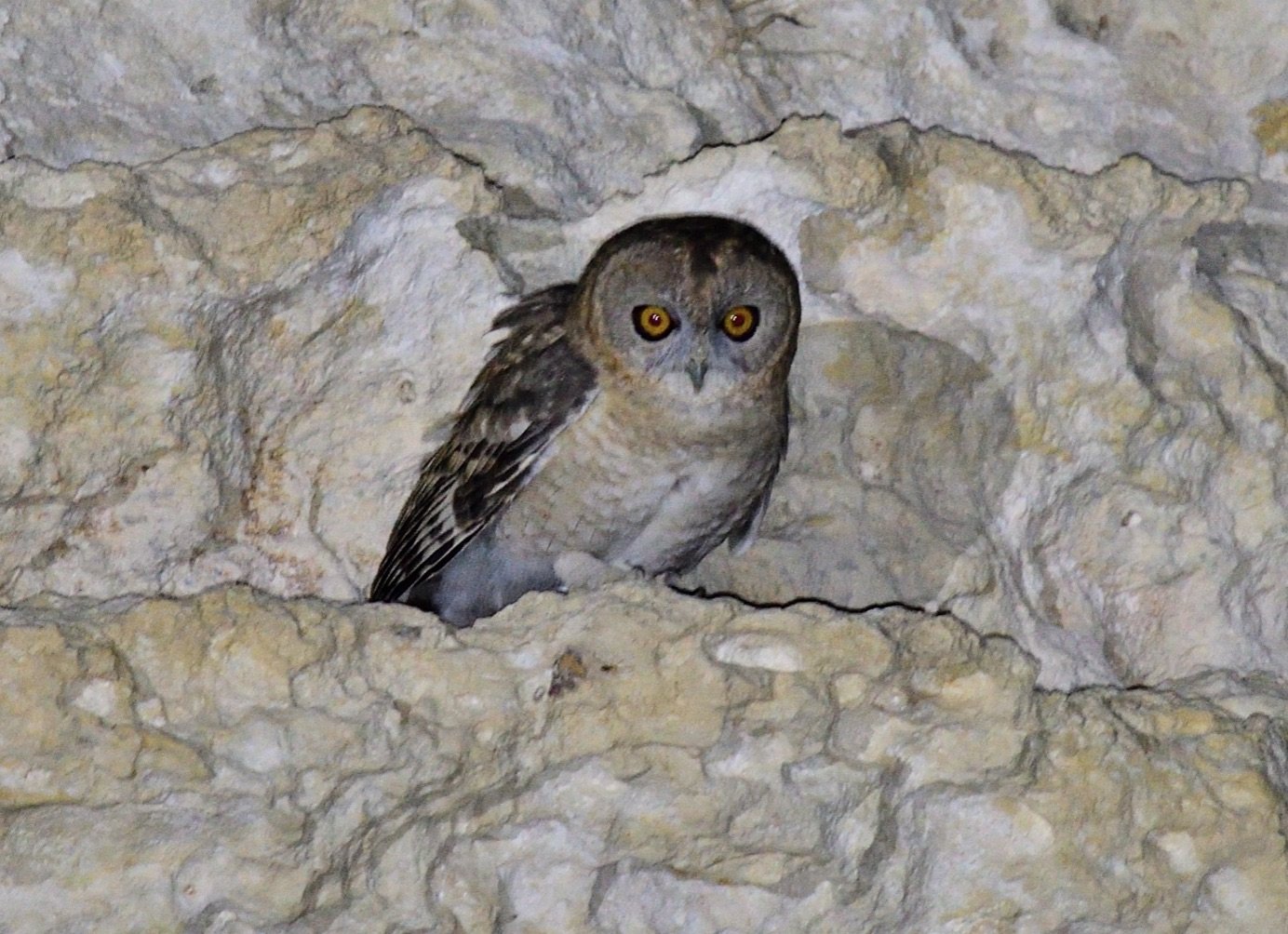
Heading further west towards the Yemen border is Khawr Mughsayl, another rarity hotspot where we have seen Cotton Pygmy Goose, Pheasant-tailed Jacana, Malachite Kingfisher and Oman's 5th Lesser White-fronted Goose. There's usually a few Red-knobbed Coots present and all the usual shorebirds, gulls and terns. The nearby beach is where we usually have our picnic lunch in the shade of one of the numerous buildings and even during midday a seawatch is worthwhile either here or from the restaurant overlooking the famous blow-hole. We've had White-cheeked Terns fishing right in front of us, both boobies are usually present, there's a huge flock of Socotra Cormorants somewhere in the bay, and we've even had Persian Shearwater, Jouanin's Petrel and Common Noddy just offshore too. Once a rare Lesser Noddy flew by! It all depends if there's any fishing boats present! And just inland from here is Wadi Mughsayl, THE site for Desert Owl, although we have found our own site now for the owl. This wadi is a great place to get Arabian and Sand Partridges in the same flock, close views of Arabian Wheatear and sometimes Hooded Wheatear, This is only 45 minutes from our hotel so we may well visit a couple of times as it is a great area.
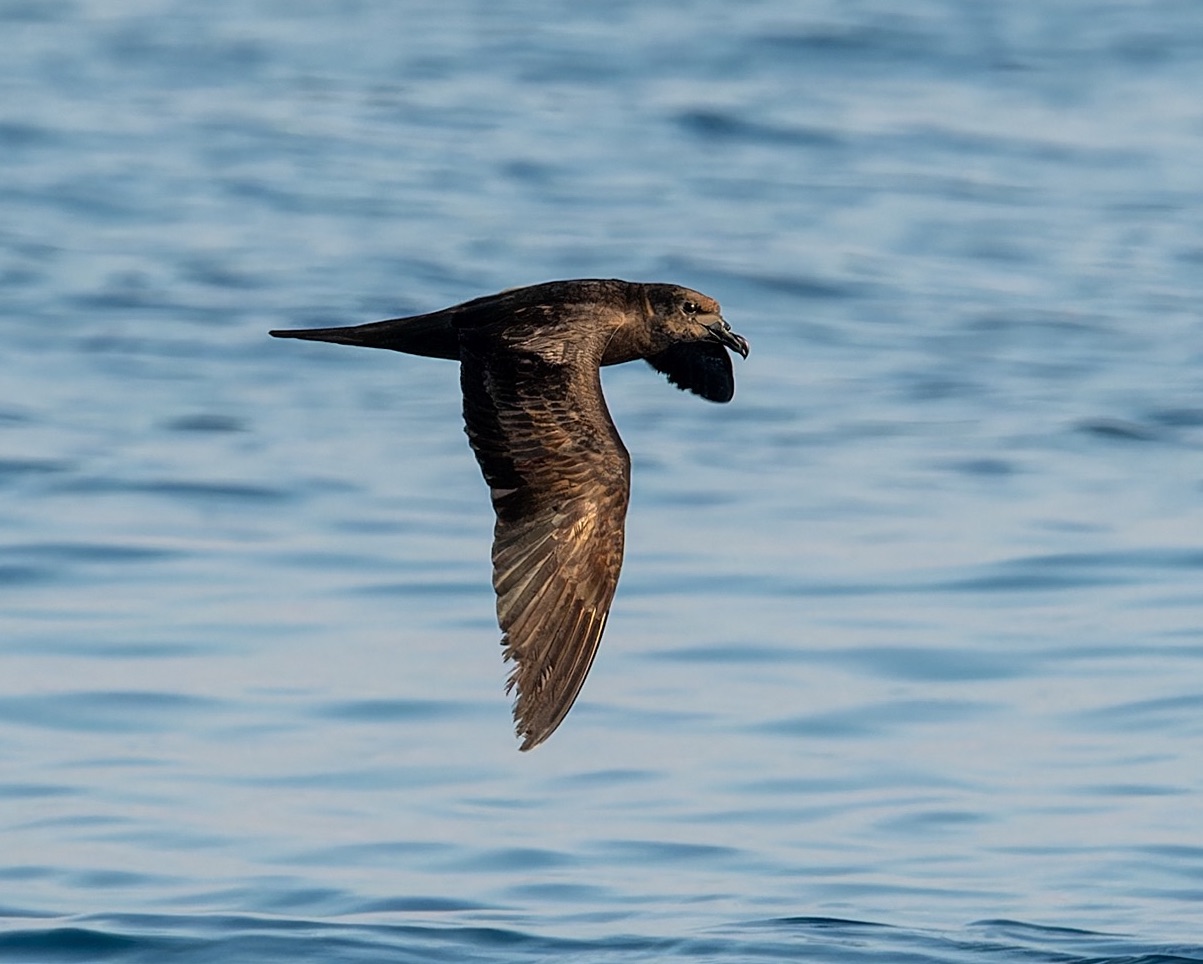
And one morning we will undertake a pelagic out of Mirbat, just under an hour's drive from Salalah. The edge of the continental shelf isn't too far offshore and with the aid of some chum we hope to entice Jouanin's Petrel, Persian & Flesh-footed Shearwaters in for close views, whilst we should also see Masked Booby, Socotra Cormorant, Bridled Tern, and many Sooty Gulls, and hopefully something rarer! We've also seen Swinhoe's Storm-Petrel on a couple of occasions and on our 2024 tour we even had a potential Matsudaira's Storm-Petrel. Some nearby green areas can be extremely productive for rarities and can hold a large flock of Rosy Starlings, along with Asian Koel, Clamorous Reed Warblers are usually showy, there's usually a few shrikes present, many Western Yellow Wagtails and in January 2025 a Brahminy Starling was present.
Birding around Salalah is extremely exciting!
DAYS 15 END OF TOUR
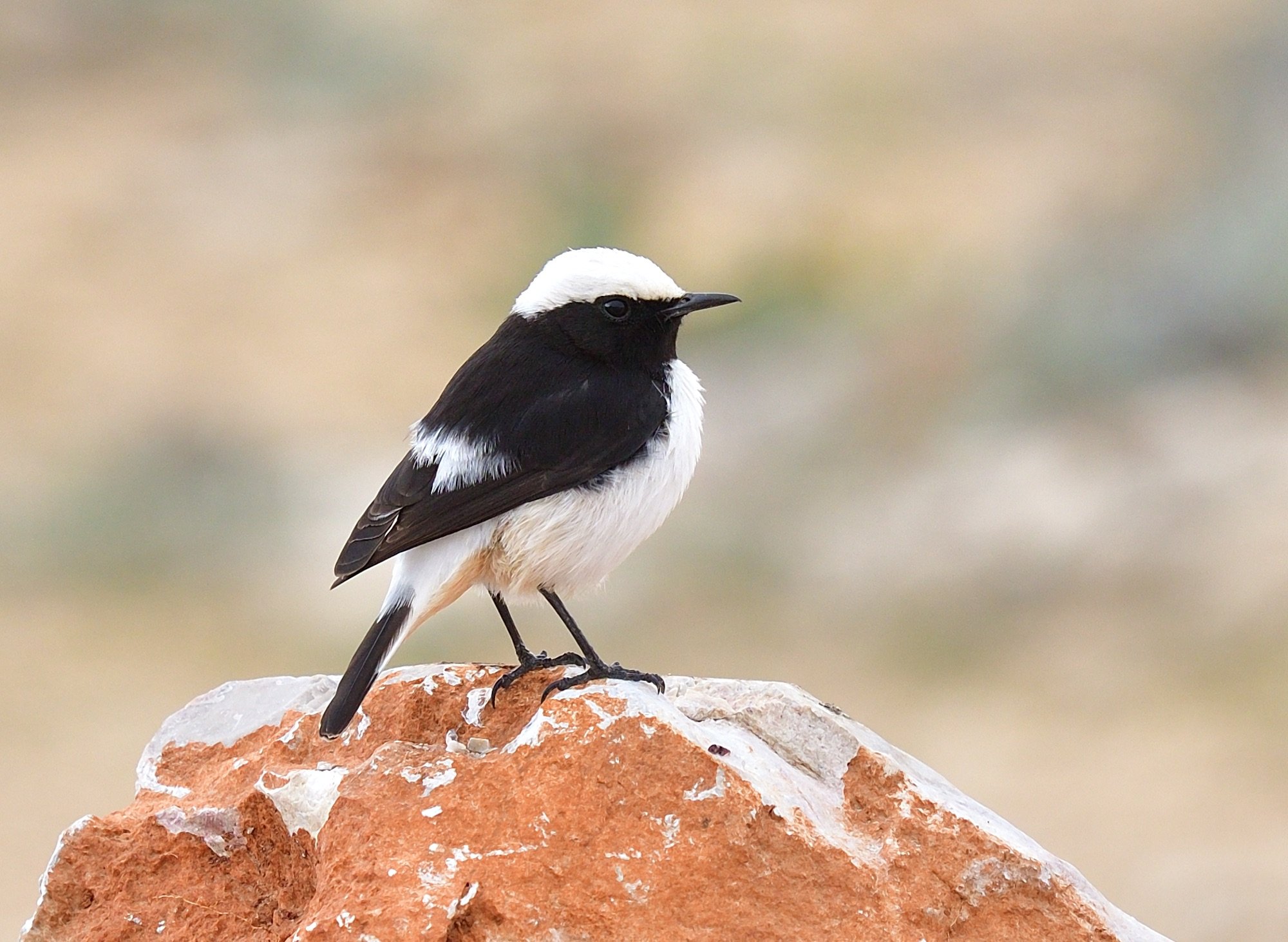
This morning we will transfer to Salalah airport for our departing flights and the end of a wonderful tour.
